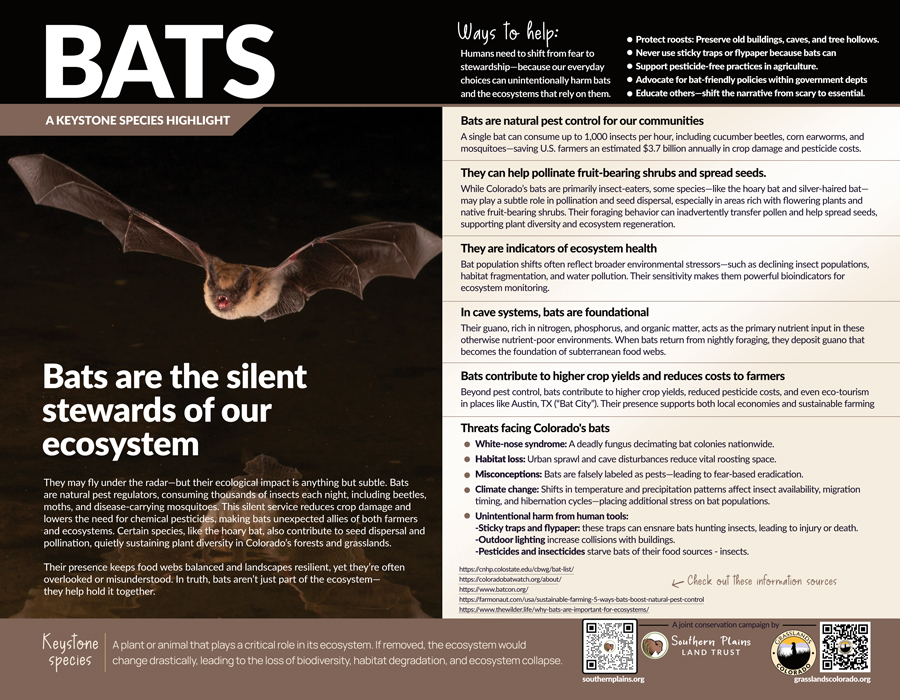
Bats are the silent stewards of our ecosystem
They may fly under the radar—but their ecological impact is anything but subtle. Bats are natural pest regulators, consuming thousands of insects each night, including beetles, moths, and disease-carrying mosquitoes. This silent service reduces crop damage and lowers the need for chemical pesticides, making bats unexpected allies of both farmers and ecosystems. Certain species, like the hoary bat, also contribute to seed dispersal and
pollination, quietly sustaining plant diversity in Colorado’s forests and grasslands.
Their presence keeps food webs balanced and landscapes resilient, yet they’re often overlooked or misunderstood. In truth, bats aren’t just part of the ecosystem—they help hold it together.
Bats are natural pest control for our communities
A single bat can consume up to 1,000 insects per hour, including cucumber beetles, corn earworms, and mosquitoes—saving U.S. farmers an estimated $3.7 billion annually in crop damage and pesticide costs
They can help pollinate fruit-bearing shrubs and spread seeds.
While Colorado’s bats are primarily insect-eaters, some species—like the hoary bat and silver-haired bat—may play a subtle role in pollination and seed dispersal, especially in areas rich with flowering plants and native fruit-bearing shrubs. Their foraging behavior can inadvertently transfer pollen and help spread seeds, supporting plant diversity and ecosystem regeneration.
They are indicators of ecosystem health
Bat population shifts often reflect broader environmental stressors—such as declining insect populations, habitat fragmentation, and water pollution. Their sensitivity makes them powerful bioindicators for ecosystem monitoring
In cave systems, bats are foundational
Their guano, rich in nitrogen, phosphorus, and organic matter, acts as the primary nutrient input in these otherwise nutrient-poor environments. When bats return from nightly foraging, they deposit guano that becomes the foundation of subterranean food webs.
Bats contribute to higher crop yields and reduces costs to farmers
Beyond pest control, bats contribute to higher crop yields, reduced pesticide costs, and even eco-tourism in places like Austin, TX (“Bat City”). Their presence supports both local economies and sustainable farming
Threats facing Colorado's bats
- White-nose syndrome: A deadly fungus decimating bat colonies nationwide.
- Habitat loss: Urban sprawl and cave disturbances reduce vital roosting space
- Misconceptions: Bats are falsely labeled as pests—leading to fear-based eradication.
- Climate change: Shifts in temperature and precipitation patterns affect insect availability, migration timing, and hibernation cycles—placing additional stress on bat populations.
- Unintentional harm from human tools:
-Sticky traps and flypaper: these traps can ensnare bats hunting insects, leading to injury or death.
-Outdoor lighting increase collisions with buildings.
-Pesticides and insecticides starve bats of their food sources - insects. animal husbandry, and habitat planning—that protect both wolves and livestock.
Ways to help:
Humans need to shift from fear to stewardship—because our everyday choices can unintentionally harm bats and the ecosystems that rely on them. Support Colorado’s wolf reintroduction and coexistence efforts
- Protect roosts: Preserve old buildings, caves, and tree hollows.
- Never use sticky traps or flypaper because bats can
- Support pesticide-free practices in agriculture.
- Advocate for bat-friendly policies within government depts
- Educate others—shift the narrative from scary to essential.
Check out these information sources:
https://cnhp.colostate.edu/cbwg/bat-list/
https://coloradobatwatch.org/about/
https://farmonaut.com/usa/sustainable-farming-5-ways-bats-boost-natural-pest-control
https://www.thewilder.life/why-bats-are-important-for-ecosystems/
Keywords to use in Social posts:
#ColoradoWildlife #GrasslandsColorado #KeystoneSpecies #BatsMatter #EcosystemStewards #BatsForBalance #HabitatConnectivity #ProtectWildCorridors #RewildColorado #RewildtheWest #Biodiversity #NativeHabitat #LivingWithBats #CoexistInColorado #FrontRangeWildlife